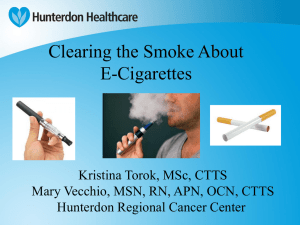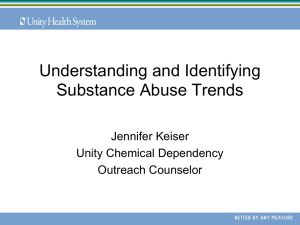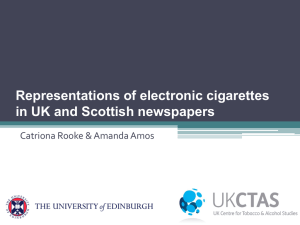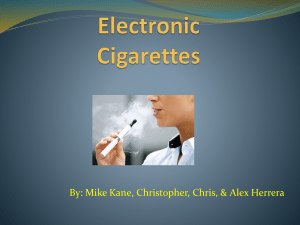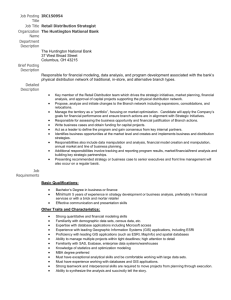ASH Scotland Electronic nicotine delivery systems (ENDS)/E-cigarettes
advertisement
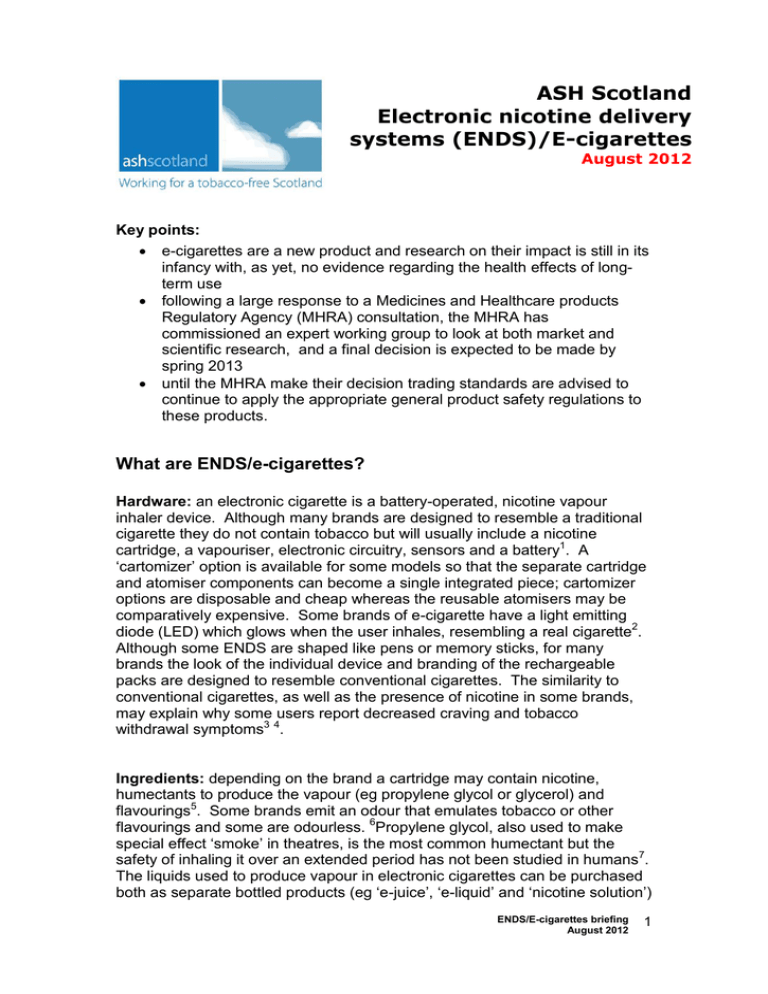
ASH Scotland Electronic nicotine delivery systems (ENDS)/E-cigarettes August 2012 Key points: e-cigarettes are a new product and research on their impact is still in its infancy with, as yet, no evidence regarding the health effects of longterm use following a large response to a Medicines and Healthcare products Regulatory Agency (MHRA) consultation, the MHRA has commissioned an expert working group to look at both market and scientific research, and a final decision is expected to be made by spring 2013 until the MHRA make their decision trading standards are advised to continue to apply the appropriate general product safety regulations to these products. What are ENDS/e-cigarettes? Hardware: an electronic cigarette is a battery-operated, nicotine vapour inhaler device. Although many brands are designed to resemble a traditional cigarette they do not contain tobacco but will usually include a nicotine cartridge, a vapouriser, electronic circuitry, sensors and a battery1. A ‘cartomizer’ option is available for some models so that the separate cartridge and atomiser components can become a single integrated piece; cartomizer options are disposable and cheap whereas the reusable atomisers may be comparatively expensive. Some brands of e-cigarette have a light emitting diode (LED) which glows when the user inhales, resembling a real cigarette2. Although some ENDS are shaped like pens or memory sticks, for many brands the look of the individual device and branding of the rechargeable packs are designed to resemble conventional cigarettes. The similarity to conventional cigarettes, as well as the presence of nicotine in some brands, may explain why some users report decreased craving and tobacco withdrawal symptoms3 4. Ingredients: depending on the brand a cartridge may contain nicotine, humectants to produce the vapour (eg propylene glycol or glycerol) and flavourings5. Some brands emit an odour that emulates tobacco or other flavourings and some are odourless. 6Propylene glycol, also used to make special effect ‘smoke’ in theatres, is the most common humectant but the safety of inhaling it over an extended period has not been studied in humans7. The liquids used to produce vapour in electronic cigarettes can be purchased both as separate bottled products (eg ‘e-juice’, ‘e-liquid’ and ‘nicotine solution’) ENDS/E-cigarettes briefing August 2012 1 for use with refillable cartridges and as pre-filled disposable cartridges. There are many different flavourings available8 eg vanilla, cinnamon, menthol, cherry delight etc and the nicotine component is usually available in a range of concentrations. Liquids have previously been marketed as containing active medicinal ingredients with therapeutic properties such as rimonabant (once marketed as an anti-obesity drug, now withdrawn) and tadalafil (an erectile dysfunction treatment). However analysis has shown that the amount of active ingredient in e-cigarette liquids marketed as containing therapeutic medicinal ingredients did not correspond with labelling, products were misbranded and broke many aspects of the US Federal Food, Drug, and Cosmetic act by essentially being unapproved new drugs9 10. Nicotine-free solutions are also available although nicotine has been detected in some products labelled as containing no nicotine11. Usage: on inhalation the cartridge is heated and a fine mist is produced. Ecigarettes administer vapourised substances to the bronchia, lung and bloodstream12 though some odourless vapour is released into the air as the smoker exhales. Higher vacuums may be required to smoke e-cigarettes13 and as aerosol density tends to drop after the first ten puffs, still stronger suction is required thereafter; it is too early to know whether stronger inhaling and diminishing amounts of aerosol will have an effect on human health. The e-cig or ‘vaper’ community The introduction of the e-cigarette has been accompanied by online groupings of users calling themselves ‘vapers’ (because they inhale vapour, not smoke) who share their experiences, review products and advocate for greater use of e-cigarettes14. These include: www.eccauk.org Electronic Cigarette Consumer Association UK www.ecigarettereview.com Electronic Cigarette Reviews UK www.e-cigarette-forum.com E-cigarette Forum www.world-vaping-day.com World Vaping Day (March 12th) It has been suggested that the Internet has fuelled the e-cigarette phenomenon15, and Google has labelled ‘electronic cigarettes’ a ‘breakout term’ where breakout is defined as a phrase which has seen a change in growth greater than 5,000 per cent. There is a great deal of information about e-cigarettes on the Internet, indeed YouTube videos have provided a valuable resource for researchers studying their usage16. Vapers sometimes modify their devices17 to produce a 'heavy-duty' nicotine burst. This is typically achieved by using lithium batteries larger than those found in off-the-shelf products, or by stacking batteries. There were reports in the media of a Florida man whose e-cigarette exploded in his mouth blowing out his teeth and part of his tongue and it seems likely that he was using a modified product (a ‘mod’)18. ENDS/E-cigarettes briefing August 2012 2 Development of the e-cigarette The electronic cigarette was developed in China in 2004 by Beijing SBT Ruyan Technologies and Development19 and it was they who registered the first international patent in 200720, although there are now many different manufacturers of and variations in the product. Even the same models within brands may display significant variations21. In the UK e-cigarettes began to gain popularity in 2007 and 200822 and they are reported as being increasingly popular in countries which have strong tobacco control regulations23. There is relatively little independent market information available on ecigarettes, what data does exist suggests large growth in sales in countries following their introduction. One analysis estimates the e-cigarette category has grown over 100% each year since its introduction to the US market, from $5m in sales in 2007 to $250m in 2011, to an estimated $500m in 201224. An Edinburgh-based company called Skycig UK, recently (July 2012) reported25 a 1,000 per cent rise in sales in the past year and predicted that the UK market for electronic cigarettes would be worth around £250 million by 2014. The ENDS industry in the UK is represented by a recently-formed body called the Electronic Cigarette Industry Trade Association (ECITA) details of which may be found at www.ecita.org.uk Scientific evidence about ENDS/E-cigarettes E-cigarettes are a new product and research on their impact is still in its infancy with, as yet, no evidence regarding the health effects of long-term use26 27 28. Potential problems: The World Health Organisation (WHO) stated in 2008 that the electronic cigarette is not a proven nicotine replacement therapy; WHO has ‘no scientific evidence to confirm the product’s safety and efficacy’ and has called for marketers to conduct clinical studies and toxicity analyses29. A small study investigating the short-term pulmonary effects of using ecigarettes found that there were immediate adverse physiologic effects similar to some of the effects seen with tobacco smoking30. However, the authors also commented ‘Notably, because these short-term effects were present even after only very limited usage, and a normal consumer would use the product most likely many times a day, it is possible that if ecigarette use were a short-term bridge to smoking cessation, the long-term health benefits associated with their use might outweigh the short-term risks; however, this would need to be clarified.’ A case study published in the journal ‘Chest’ in April 2012 suggested a previously unforeseen health risk of e-cigarette use: exogenous lipoid pneumonia due to glycerin-based e-cigarettes. Exogenous lipoid pneumonia is a chronic inflammatory reaction to the deposition of lipid substances in the lung, typically as a result of aspiration or inhalation of oilENDS/E-cigarettes briefing August 2012 3 based products31. However, this was a single case study and the patient had underlying health problems. A study has shown that stronger puffing is needed to smoke most brands of ENDS than with conventional cigarettes and smoking characteristics like vacuum and density vary considerably between brands32. More information is needed about any possible effects ENDS might have on the lungs with long-term usage. Tests of two brands by the Food and Drug Administration (FDA) in the United States revealed trace levels of tobacco-specific nitrosamines and inconsistent quality control processes33. In a 2010 clinical laboratory study e-cigarettes suppressed cravings less effectively than cigarettes and failed to increase nicotine levels significantly 34 . It is worth noting that that the author of this research subsequently coauthored a study which demonstrated that e-cigarettes alone are capable of increasing plasma nicotine concentrations to levels seen during cigarette smoking35, and one which concluded that they can deliver clinically significant amounts of nicotine and reduce cigarette abstinence symptoms and appear to have lower potential for abuse relative to traditional tobacco cigarettes, at least under certain laboratory conditions36. Potential benefits: e-cigarettes do not produce second-hand smoke, although there has been a call for more research to evaluate their impact on indoor air quality and to estimate the possible effect of passive vaping37. a Ruyan commissioned safety report concluded that their e-cigarette is safe, relative to cigarettes, and contained only trace levels of tobacco smoke toxicants38. tests carried out by manufacturer NJOY in response to the FDA study found no evidence of carcinogenic tobacco-specific N-nitrosamines in the aerosol from NJOY electronic cigarettes39. Greek research institute Demokritos found no evidence of polycyclic aromatic hydrocarbons in its toxological analyses on electronic cigarettes40. a trial41 found that a Ruyan brand e-cigarette containing nicotine alleviated the desire to smoke as well as a conventional Nicorette nicotine inhalator, performed significantly better than a placebo e-cigarette, and was rated more pleasant to use than the inhalator. a study has shown that cotinine levels in ENDS users were similar to levels observed, in previous reports, in smokers and higher than levels usually observed in NRT users42, suggesting that previous studies that had found no elevation in biomarkers of nicotine may be a result of participants being naïve users who were unfamiliar with how to use e-cigarettes effectively. a clinical trial43 found that ‘in spite of delivering no measurable nicotine, both electronic cigarettes tested in this study reduced ratings of “craving a cigarette” and “urge to smoke” and increased subjective ratings of product acceptability (e.g. “satisfying,” “taste good,” “pleasant”)’. These results are consistent with anecdotal reports from long-term electronic cigarette users and support the notion that electronic cigarettes may provide an alternative, perhaps a substitute, to cigarette smoking in some cases. ENDS/E-cigarettes briefing August 2012 4 a study has found that one brand of e-cigarette alleviated desire to smoke and withdrawal symptoms 20 min after use although the nicotine content was more important for males44. a small case series study with three cases found that smokers with a documented history of recurring relapses were able to quit and to remain abstinent for at least six months after taking up an E-cigarette45. a prospective 6-month pilot study (n40) found that the use of e-cigarettes substantially decreased cigarette consumption without causing significant side effects in smokers not intending to quit46. After 6 months a 50% reduction in the number of cigarettes per day was shown by just over 30% of participants, with sustained smoking abstinence observed in just over 20%. in a study using an online survey of 222 first time e-cigarettes purchasers 47 the primary fınding was that the six-month point prevalence of smoking abstinence among the e-cigarette users in the sample was 31.0% (95% CI 24.8%, 37.2%). A large percentage of respondents reported a reduction in the number of cigarettes they smoked (66.8%) and almost half reported abstinence from smoking for a period of time (48.8%). Those respondents using e-cigarettes more than 20 times per day had a quit rate of 70.0%. Of respondents who were not smoking at six months, 34.3% were not using e-cigarettes or any nicotine-containing products at the time. A limitation of the study was the low response rate of 4.5%, making selection bias likely. Some tobacco control issues raised by ENDS/e-cigarettes Nicotine exposure: Direct epidemiological studies of the health effects of long term ‘pure’ nicotine use are limited. However, the available evidence has resulted in a general consensus that, while nicotine use probably carries some risks, in the dosages delivered to the user by smoking it is generally quite a safe drug48. Probable or suspected harmful effects of nicotine include effects on the cardiovascular system, adverse reproductive effects, and impairment of wound healing49. However in many cases (such as the provision of nicotine replacement therapy to high-risk patients with cardiac disease50) limited excess risk has been detected in clinical studies, or (as in the case of postoperative complications51) if excess risk exists, it is likely to be small compared to the risk of continuing to smoke. Animal models suggested a role of nicotine in the promotion of tumour growth52 53 however this has yet to be established in human epidemiology. There are currently no clinical studies on the effects of long-term nicotine use from the mode of administration used by ENDS. In concentrated forms, nicotine is a dangerous poison with a fatal human dose of around 60mg, less for children. Nicotine concentration in e-cigarette liquid can vary from 6 mg/ml to 24 mg/ml upwards. This means that harmful doses of nicotine can be present in bottles of e-liquid refills. Because of the dangers presented by accidental exposure to high concentrations of nicotine, there has been concern that ENDS products should be adequately regulated to ENDS/E-cigarettes briefing August 2012 5 minimise this possibility. A 2010 analysis of ENDS products found that:54 ‘Batteries, atomisers, cartridges, cartridge wrappers, packs and instruction manuals lack important information regarding ENDS contents, use and essential warnings. ENDS cartridges leak, thereby creating the potential for unwanted nicotine exposure to children, adults, pets and the environment. There are currently no methods for proper disposal of ENDS products and accessories, including cartridges.’ Medicinal versus recreational nicotine: it has been argued in the International Journal of Drug Policy55 that ‘by delivering nicotine in a way that resembles the visual spectacle and bodily pleasures of smoking, but without the harms of combustible tobacco, e-cigarettes highlight the complex status of nicotine as both a poison and remedy in contemporary public health and tobacco control’. Promotion of smoking/gateway product: the World Health Organization has expressed concern56 that ENDS might undermine the prevention of tobacco use because of their appearance, sweet flavourings and marketing as safe alternatives to tobacco products for non-tobacco users, including children. Dual use: the World Health Organization has also expressed concern that ENDS might be used to perpetuate smoking by sustaining nicotine dependence in smoke-free environments57. They cite de-normalization of tobacco product use and the subsequent increase in cessation rates as one of the positive consequences of smoking restrictions. They also suggest that ENDS may discourage people from quitting, as users can maintain their nicotine addiction despite smoking restrictions and resume smoking where such restrictions are absent. However, others58 have argued that dual use is of limited concern as existing surveys show that most current e-cigarette users use e-cigarettes for complete or partial replacement of smoked cigarettes rather than supplementation. Tobacco industry involvement: a criticism of current ENDS products has been that they are inconsistent mechanisms for nicotine delivery59. However they are rapidly evolving products and it is likely that adaptations which facilitate efficient pulmonary delivery to a greater extent will be made60. Shortly after the US Food and Drug Administration announced that ENDS would be regulated as tobacco products both Philip Morris and British American Tobacco purchased nicotine-inhaler technologies that promise pulmonary delivery61. It is also worth noting that the Centre for Tobacco Research at the University of Catania (source of one of the first pieces of evidence suggesting that e-cigarettes can help smokers quit) was founded with funding from Philip Morris, and the financial links between Philip Morris and the University's research into e-cigarettes fit the broader context of tobacco companies' investment in alternative use of tobacco62. ENDS/E-cigarettes briefing August 2012 6 Regulatory issues Electronic cigarettes are problematic to regulate; they do not fit into current legislation for several reasons: they are not tobacco products and therefore are not regulated by Tobacco Product Regulations. although they both contain nicotine the electronic cigarette is not automatically subject to the same regulations as nicotine replacement therapies. Several nations have opted to ban the sale and importation of electronic cigarettes outright; these include Argentina63, Brazil64, Israel65 and Singapore66; (the Vapers Network monitors e-cig legislation worldwide67). Others nations have opted to classify electronic cigarettes as medicinal products and regulate accordingly; these include Denmark, although as no ENDS have yet been recognised as medicinal products they are effectively banned68. The Health and Consumer Protection Directorate-General of the European Commission has reviewed electronic cigarettes and EC legislation and suggested that whether electronic cigarettes are a medical device depends on the ‘claimed intended use and whether this intended use has a medical purpose or not’69. They further suggest that national authorities should decide the status of each product on a case-by-case basis. In the USA the Food and Drug Administration (FDA) declared (April 2011) that it will regulate ‘electronic cigarettes’ as tobacco products, having failed in its initial attempt to regulate them as drug-delivery devices70. Under the 2009 Family Smoking Prevention and Tobacco Control Act products containing nicotine derived from tobacco but making no therapeutic claims must be regulated as ‘tobacco products’71. UK regulations The tobacco control strategy introduced in February 2010 by the previous Westminster Government suggested that all products which contain nicotine should be regulated under medicines safety legislation 72. A Medicines and Healthcare products Regulatory Agency (MHRA) consultation73 invited responses on proposals to regulate all nicotine-containing products as medicines by function, rather than by claim, therefore e-cigarettes and other nicotine-containing products would be regulated in the same way as existing pharmaceutical nicotine products. There was a very large response to the consultation and the MHRA has now commissioned an expert working group to look at both market and scientific research74. A final decision is expected to be made by Spring 2013 but until then the MHRA have stated that trading standards are advised to continue to apply the appropriate general product safety regulations to these products. Within the UK the electronic cigarette is currently regulated under two different schemes: ENDS/E-cigarettes briefing August 2012 7 medicines and medical devices are regulated by the MHRA; electronic cigarettes which market themselves as smoking cessation devices (explicitly or implicitly) must be approved by the MHRA75. products which market themselves as alternatives to cigarettes are not currently subject to regulation by the MHRA; these devices may instead be regulated by trading standards bodies. the safety of e-cigarettes marketed as tobacco alternatives is currently controlled by general product safety legislation and the Chemicals (Hazard Information & Packaging for Supply) Regulations 2002 (CHIP). These require electronic cigarettes to be supplied with child-resistant packaging and toxic warning labels 76. In 2009 LACORS (the Local Authorities Coordinators of Regulatory Services) carried out testing on several brands of electronic cigarette. All had failed to comply with the requirements of the Chemicals (Hazard Information & Packaging for Supply) Regulations 2002 (CHIP)77, although this situation may have since changed. The Department of Health is working with LACORS and local authorities to ensure compliance with current regulations. It is hoped that bringing all electronic cigarettes into regulation under the MHRA will ensure products are of the requisite quality, efficacy and safety to eliminate or reduce the harm from smoking78. In the absence of a comprehensive regulatory framework some organisations have made their own decisions. For example, Fife Health Board has banned e-cigarette usage citing a lack of information about their long-term usage alongside fears that the heating element could cause bedding or clothing to ignite79. Similarly Standard Life will not allow employees to use e-cigarettes at their desk, considering it to be a violation of a long-standing, no-smoking policy80. Conclusion The two areas on which almost all of the research cited in this paper agree upon is that more research is needed on the harms and benefits of ecigarettes, and that effective regulation is needed to ensure controlled manufacture renders any such products both safe and effective. References 1 Borland R, Gray N. Editorial: Electronic cigarettes as a method of tobacco control. British Medical Journal 2011, 343: 1238. http://www.bmj.com/content/343/bmj.d6269.pdf%2Bhtml [Accessed 27 July 2012] 2 Etter, J.F. Electronic cigarettes: a survey of users. BMC Public Health [online]. 2010, 10:231. Available from: www.biomedcentral.com/1471-2458/10/231/abstract [Accessed 27 July 2012] 3 Bullen C et al. Effect of an electronic nicotine delivery device (e cigarette) on desire to smoke and withdrawal, user preferences and nicotine delivery: randomised cross-over trial. Tobacco Control 2010;19:98–103. http://tobaccocontrol.bmj.com/content/19/2/98.abstract [Accessed 31 July 2012] ENDS/E-cigarettes briefing August 2012 8 4 Vansickel AR et al. A clinical laboratory model for evaluating the acute effects of electronic “cigarettes”: nicotine delivery profile and cardiovascular and subjective effects. Cancer Epidemiology Biomarkers and Prevention 2010;19:1945–53. www.ncbi.nlm.nih.gov/pubmed/20647410 [Accessed 31 July 2012] 5 Etter JF et al, Electronic nicotine delivery systems: a research agenda. Tobacco Control 2011;20:243-248. http://tobaccocontrol.bmj.com/content/20/3/243.short?rss=1 [Accessed 31 July 2012] 6 Wollscheid K.A, Kremzner ME. (2009). Electronic cigarettes: Safety concerns and regulatory issues. American Journal of Health-System Pharmacy, October 1, 2009, 66, 1740–1742. www.ajhp.org/content/66/19/1740.citation [Accessed 03 August 2012] 7 Cobb NK, Abrams D B. E-Cigarette or Drug-Delivery Device? Regulating Novel Nicotine Products. New England Journal of Medicine, 365;3 . July 21, 2011. www.einstein.yu.edu/uploadedFiles/bronxbreathes/NEJMRegulation%20Novel%20Nicotine%20Products.pdf [Accessed 01 August 2012] 8 Westenberger BJ. US Food and Drug Administration evaluation of e-cigarettes. Center for Drug Evaluation and Research, Division of Pharmaceutical Analysis. Rockville, MD: US Food and Drug Administration; 2009. www.fda.gov/downloads/Drugs/ScienceResearch/UCM173250.pdf [Accessed 02 August 2012] 9 Hadwiger ME. Identification of amino-tadalafil and rimonabant in electronic cigarette products using high pressure liquid chromatography with diode array and tandem mass spectrometric detection. Journal of Chromatography A. 2010 Nov 26;1217(48):7547-55. www.ncbi.nlm.nih.gov/pubmed/20980012 [Accessed 31 July 2012] 10 U.S. Food and Drug Administration. Warning Letter to E-Cig Technology Inc. 8 September 2010. Available from: http://www.fda.gov/ICECI/EnforcementActions/WarningLetters/ucm225187.htm [Accessed 31 July 2012] 11 Hadwiger ME. Identification of amino-tadalafil and rimonabant in electronic cigarette products using high pressure liquid chromatography with diode array and tandem mass spectrometric detection. Journal of Chromatography A. 2010 Nov 26;1217(48):7547-55. www.ncbi.nlm.nih.gov/pubmed/20980012 [Accessed 31 July 2012] 12 Etter J F. Commentary on Wagener et al. (2012): Electronic cigarettes – the Holy Grail of nicotine replacement? Addiction Early View, Article first published online: 17 May 2012. http://onlinelibrary.wiley.com/doi/10.1111/j.1360-0443.2012.03909.x/pdf [Accessed 31 July 2012] 13 Trtchounian A, Williams M, Talbot P. Conventional and electronic cigarettes (e-cigarettes) have different smoking characteristics. Nicotine and Tobacco Research. 2010 Sep;12(9):90512. www.ncbi.nlm.nih.gov/pubmed/20644205 [Accessed 30 July 2012] 14 Ayers JW, Ribisl KM, Brownstein JS. Tracking the rise in popularity of electronic nicotine delivery systems (electronic cigarettes) using search query surveillance. American Journal of Preventive Medicine. 2011;40:448-53. www.ncbi.nlm.nih.gov/pubmed/21406279 [Accessed 27 July 2012] 15 Yamin CK, Bitton A, Bates DW. E-cigarettes: a rapidly growing internet phenomenon. Annals of Intern al Medicine 2010;153:607–9. http://annals.org/article.aspx?volume=153&issue=9&page=607 [Accessed 27 July 2012] 16 Hua M, Yip H, Talbot P. Mining data on usage of electronic nicotine delivery systems (ENDS) from YouTube videos. Tobacco Control, published on November 24, 2011 as 10.1136/tobaccocontrol-2011-050226. http://tobaccocontrol.bmj.com/content/early/2011/11/24/tobaccocontrol-2011-050226.abstract [Accessed 31 July 2012] 17 McQueen A, Tower S, Sumner W. Interviews with ‘Vapers’: implications for future research with electronic cigarettes. Nicotine and Tobacco Research 2011; 13: 860–7. www.ncbi.nlm.nih.gov/pubmed/21571692 [Accessed 31 July 2012] 18 Duell M. Vietnam veteran suffers horrific burns as electronic cigarette EXPLODES inside his mouth and blows out all of his teeth. Daily Mail, 15 February 2012. www.dailymail.co.uk/news/article-2101565/Tom-Holloway-suffers-horrific-burns-explodingelectronic-cigarette-knocks-teeth.html ENDS/E-cigarettes briefing August 2012 9 19 Pauly, J., Li, Q., and Barry, M. B. Tobacco-free electronic cigarettes and cigars deliver nicotine and generate concern. Tobacco Control [online] 16[5], 357. 2007. Available from: http://tobaccocontrol.bmj.com/content/16/5/357.1.extract [Accessed 30 July 2012] 20 Electronic Atomizer Cigarette European patent. Worldwide.espacenet.com . 2007-11-22. http://worldwide.espacenet.com/publicationDetails/biblio?CC=US&NR=2007267031&KC=&FT =E&locale=en_EP [Accessed 30 July 2012] 21 Williams M, Talbot P. Variability Among Electronic Cigarettes in the Pressure Drop, Airflow Rate, and Aerosol Production. Nicotine and Tobacco Research (2011) 13 (12): 1276-1283. http://ntr.oxfordjournals.org/content/13/12/1276.abstract [Accessed 30 July 2012] 22 Kidwell, H. When is a cigarette not a tobacco product. Tobacco Journal International [online] June 2009. Available from: www.tobaccojournal.com/When_is_a_cigarette_not_a_tobacco_product.49535.0.html [Accessed 26 July 2012] 23 Ayers JW, Ribisl KM, Brownstein JS. Tracking the rise in popularity of electronic nicotine delivery systems (electronic cigarettes) using search query surveillance. American Journal of Preventive Medicine. 2011;40:448-53. www.ncbi.nlm.nih.gov/pubmed/21406279 [Accessed 27 July 2012] 24 UBS Investment Research: US Tobacco. Clearing the smoke on e-cigarettes. 14 May 2012. UBS Securities LLC. 25 Mackie, Gareth. Electronic cigarette supplier poised to recruit after sales grow 1,000%. Scotland on Sunday, 8 July 2012. www.scotsman.com/scotland-onsunday/business/electronic-cigarette-supplier-poised-to-recruit-after-sales-grow-1-000-12399065 26 Simpson, D. World: E-cigarettes are here. Tobacco Control [online] 18[2], 80-81. 2009. Available from: www.ncbi.nlm.nih.gov/pubmed/19318533 [Accessed 27 July 2012] 27 Yamin CK, Bitton A, Bates DW. E-cigarettes: a rapidly growing internet phenomenon. Annals of Intern al Medicine 2010;153:607–9. http://annals.org/article.aspx?volume=153&issue=9&page=607 [Accessed 27 July 2012] 28 Henningfield JE, Zaatari GS. Electronic nicotine delivery systems: emerging science foundation for policy. Tobacco Control 2010;19:89–90. http://tobaccocontrol.bmj.com/content/19/2/89.full?ijkey=b862fb245c4746c48fcd608f6ade045 66b0fbe83&keytype2=tf_ipsecsha [Accessed 30 July 2012] 29 World Health Organisation. Marketers of electronic cigarettes should halt unproved therapy claims [press release] [online] 19 September 2008. Available from: www.who.int/mediacentre/news/releases/2008/pr34/en/index.html [Accessed 30 July 2012] 30 Vardavas C I et al. Short-term Pulmonary Effects of Using an Electronic Cigarette: Impact on Respiratory Flow Resistance, Impedance, and Exhaled Nitric Oxide. CHEST.2012;141(6):1400-1406. doi:10.1378/chest.11-2443. http://journal.publications.chestnet.org/article.aspx?articleid=1187047 [Accessed 02 August 2012] 31 McCauley L, Markin C, Hosmer D. An Unexpected Consequence of Electronic Cigarette Use.. CHEST 2012; 141( 4 ): 1110 – 1113. http://chestjournal.chestpubs.org/content/141/4/1110.citation [Accessed 03 August 2012] 32 Trtchounian A, Williams M, Talbot P. Conventional and electronic cigarettes (e-cigarettes) have different smoking characteristics. Nicotine and Tobacco Research. 2010 Sep;12(9):90512. www.ncbi.nlm.nih.gov/pubmed/20644205 [Accessed 30 July 2012] 33 Department of Health and Human Services, Food and Drug Administration. Evaluation of E-cigarettes [online] May 2009. Available from: www.fda.gov/downloads/Drugs/ScienceResearch/UCM173250.pdf [Accessed 30 July 2012] 34 Eissenberg, Thomas. Electronic nicotine delivery devices: ineffective nicotine delivery and craving suppression after acute administration. Tobacco Control [online] 19[1], 87-88. 2010. Available from: www.ncbi.nlm.nih.gov/pmc/articles/PMC3208854/ [Accessed 30 July 2012] 35 Vansickel A R, Eissenberg T. Electronic Cigarettes: Effective Nicotine Delivery After Acute Administration. Nicotine and Tobacco Research, 2012: ntr316v1-ntr316. http://ntr.oxfordjournals.org/content/early/2012/02/05/ntr.ntr316.abstract [Accessed 09 August 2012] 36 Vansickel AR, Cobb CO, Weaver MF, Eissenberg TE. A clinical laboratory model for evaluating the acute effects of electronic "cigarettes": nicotine delivery profile and cardiovascular and subjective effects. Cancer Epidemiol Biomarkers Prev. 2010 Aug;19(8):1945-53. www.ncbi.nlm.nih.gov/pubmed/20647410 [Accessed 30 July 2012] ENDS/E-cigarettes briefing August 2012 10 37 Schripp T, Markewitz D, Uhde E, Salthammer T. Does e-cigarette consumption cause passive vaping? Indoor.Air. 2-6-2012. www.ncbi.nlm.nih.gov/pubmed/22672560 [Accessed 06 August 2012] 38 Laugesen, M. Safety Report on the Ruyan® e-cigarette Cartridge and Inhaled Aerosol [online] Christchurch, New Zealand: Health New Zealand Ltd. October 2008. Available from: www.healthnz.co.nz/RuyanCartridgeReport30-Oct-08.pdf [Accessed 30 July 2012] 39 Ben Thomas Group, LLC. Tobacco-Specific Nitrosamines (TSNAs) in NJOY Electronic Cigarettes [online] 2009. Available from: www.e-cig.org/pdfs/Study-to-Determine-Presenceof-TSNAs-in-NJOY-Vapor.pdf [accessed 30 July 2012] 40 Flouris, A. D. and Oikonomou, D. N. Electronic cigarettes: miracle or menace? BMJ 340, c311. 2010. Available from: www.bmj.com/cgi/content/extract/340/jan19_1/c311 [Accessed 8 February 2010] 41 Bullen C, McRobbie H, Thornley S, Glover M, Lin R, Laugesen M. Effect of an electronic nicotine delivery device (e cigarette) on desire to smoke and withdrawal, user preferences and nicotine delivery: randomised cross-over trial. Tobacco Control. 2010 Apr;19(2):98-103. http://tobaccocontrol.bmj.com/content/19/2/98.abstract?sid=67a9ccc2-47a3-4a5f-891f94dc6dc6acb2 [Accessed 30 July 2012] 42 Etter JF, Bullen C. Saliva cotinine levels in users of electronic cigarettes. European Respiratory Journal. 2011, Nov 1, vol 38, 1219-1220. 43 Vansickel AR, Cobb CO, Weaver MF, Eissenberg TE. A clinical laboratory model for evaluating the acute effects of electronic "cigarettes": nicotine delivery profile and cardiovascular and subjective effects. Cancer Epidemiol Biomarkers Prev. 2010 Aug;19(8):1945-53. www.ncbi.nlm.nih.gov/pubmed/20647410 [Accessed 30 July 2012] 44 Dawkins, L., Turner, J., Hasna, S., and Soar, K. The electronic-cigarette: effects on desire to smoke, withdrawal symptoms and cognition. Addictive Behaviors 37[8], 970-973. 2012. Abstract or full text available at: www.ncbi.nlm.nih.gov/pubmed/22503574 [Accessed 06 August 2012] 45 Caponnetto P, Polosa R, Russo C, Leotta C, Campagna D. J. Successful smoking cessation with electronic cigarettes in smokers with a documented history of recurring relapses: a case series. Medical Case Reports. 2011 Dec 20;5(1):585. www.jmedicalcasereports.com/content/5/1/585 [Accessed 02 August 2012] 46 Polosa R et al. Effect of electronic nicotine delivery device (e-cigarette) on smoking reduction and cessation: a prospective 6-month pilot study. BMC Public Health 2011; 11: 786. www.biomedcentral.com/1471-2458/11/786 / [Accessed 31 July 2012] 47 Siegel MB, Tanwar K.L, Wood K.S. Electronic cigarettes as a smoking cessation tool. American Journal of Preventive Medicine 2011; 40: 472–5. 48 Royal College of Physicians. Harm reduction in nicotine addiction: helping people who can’t quit. A report by the Tobacco Advisory Group of the Royal College of Physicians. London: RCP, 2007 49 Benowitz NL. Pharmacology of Nicotine: Addiction, Smoking-Induced Disease, and Therapeutics. Annual Review of Pharmacology and Toxicology Vol. 49: 57-71 (Volume publication date February 2009). 50 Joseph AM, Norman SM, Ferry LH, Prochazka AV, Westman EC, Steele BG, Sherman SE, Cleveland M, Antonuccio DO, Hartman N, McGovern PG. The safety of transdermal nicotine as an aid to smoking cessation in patients with cardiac disease. N Engl J Med. 1996 Dec 12;335(24):1792-8. Erratum in: N Engl J Med. 2007 Jun 14;356(24):2554. 51 Møller AM, Villebro N, Pedersen T, Tønnesen H. Effect of preoperative smoking intervention on postoperative complications: a randomised clinical trial. Lancet. 2002 Jan 12;359(9301):114-7. 52 Davis R et al. Nicotine promotes tumor growth and metastasis in mouse models of lung cancer. PLoS One 2009;4:e7524. www.ncbi.nlm.nih.gov/pubmed/19841737?dopt=Abstract [Accessed 31 July 2012] 53 Heeschen C et al. Nicotine stimulates angiogenesis and promotes tumor growth and atherosclerosis. Nature Medicine 2001;7:833–9. www.ncbi.nlm.nih.gov/pubmed/11433349?dopt=Abstract [Accessed 31 July 2012] 54 Trtchounian A, Talbot P. Electronic nicotine delivery systems: is there a need for regulation? Tobacco Control 2011;20:47-52. ENDS/E-cigarettes briefing August 2012 11 http://tobaccocontrol.bmj.com/content/early/2010/10/22/tc.2010.037259.abstract [Accessed 31 July 2012] 55 Bell, K. and Keane, H. Nicotine control: E-cigarettes, smoking and addiction. Int.J.Drug Policy 23[3], 242-247. 2012. www.ncbi.nlm.nih.gov/pubmed/22365155 [Accessed 06 August 2012] 56 World Health Organization. Report on the scientific basis of tobacco product regulation: third report of a WHO study group. Geneva: (2010). WHO Technical Report Series, no. 955. www.who.int/tobacco/publications/prod_regulation/tsr_955/en/index.html [Accessed 27 July 2012] 57 Ibid 58 Wagener TL, Siegel M, Borrelli B. Electronic cigarettes: achieving a balanced perspective. Addiction. 2012 Sep;107(9):1545-8. 59 Eissenberg, Thomas. Electronic nicotine delivery devices: ineffective nicotine delivery and craving suppression after acute administration. Tobacco Control [online] 19[1], 87-88. 2010. Available from: http://tobaccocontrol.bmj.com/content/19/1/87.short [Accessed 30 July 2012] 60 Rose JE, Turner JE, Murugesan T, Behm FM, Laugesen M. Pulmonary delivery of nicotine pyruvate: sensory and pharmacokinetic characteristics. Experimental and Clinical Psychopharmacology 2010;18:385-94. www.ncbi.nlm.nih.gov/pubmed/20939642 [Accessed 01 August 2012] 61 Cobb NK, Abrams D B. E-Cigarette or Drug-Delivery Device? Regulating Novel Nicotine Products. New England Journal of Medicine, 365;3 . July 21, 2011. www.einstein.yu.edu/uploadedFiles/bronxbreathes/NEJMRegulation%20Novel%20Nicotine%20Products.pdf [Accessed 01 August 2012] 62 Tobacco Control Research Group, University of Bath, Tobacco Tactics wiki: E-cigarettes: Mixing Research and Marketing. www.tobaccotactics.org/index.php?title=Ecigarettes:_Mixing_Research_and_Marketing [Accessed 01 August 2012] 63 ‘Argentina bans electronic cigarettes’, The Indepenent, 10 May 2011 www.independent.co.uk/life-style/health-and-families/argentina-bans-electronic-cigarettes2282065.html [Accessed 02 August 2012] 64 Press Release Distribution, ‘E-Cigarette Bans Growing’, 02 September 2009. http://www.prlog.org/10329550-ecigarette-bans-growing-sellers-seek-liability-insurance.html [Accessed 02 August 2012] 65 ‘Health Ministry Bans Electronic Cigarettes’ Israel National News, 29 July 2009. www.israelnationalnews.com/News/News.aspx/132629#.UBpaeLKiz1U [Accessed 02 August 2012] 66 Singapore Government, ‘Prohibition on imitation tobacco products’ www.hsa.gov.sg/publish/hsaportal/en/health_products_regulation/tobacco/legislation/highlight s___prohibition.html [Accessed 02 Augusts 2012] 67 Vapers Network, http://vapersnetwork.org/legal [Accessed 26 July 2012] 68 Danish Medical Agency www.dkma.dk/1024/visUKLSArtikel.asp?artikelID=14819 69 European Commission. Orientation note: electronic cigarettes and the EC legislation [online] May 2008. Available from: http://ec.europa.eu/health/ph_determinants/life_style/Tobacco/Documents/orientation_0508_e n.pdf [Accessed 30 July 2012] 70 Regulation of E-Cigarettes and Other TobaccoProducts, April 25 2011. www.fda.gov/NewsEvents/PublicHealthFocus/ucm252360.htm [Accessed 31 July 2012] 71 Sottera, Inc. v. Food & Drug Administration, Civ. No. 09-cv-0771(RJL), (D.C. Cir. 2010). www.scribd.com/doc/54672876/NJOY-v-FDA-Stipulation-and-Order-of-Final-Judgment [Accessed 03 August 2012] 72 Department of Health. A smokefree future: a comprehensive tobacco control strategy for England [online] 2010. Available from: www.dh.gov.uk/dr_consum_dh/groups/dh_digitalassets/@dh/@en/@ps/documents/digitalass et/dh_111789.pdf [Accessed 30 July 2012] 73 Medicines Healthcare Regulators Agency. Public consultation (MLX 364): The regulation of nicotine containing products [online] 2010 - Responses from key public health-focused organisations. Available from: www.mhra.gov.uk/Publications/Consultations/Medicinesconsultations/MLXs/CON065617 [Accessed 30 July 2012] ENDS/E-cigarettes briefing August 2012 12 74 Ibid [Accessed 30 July 2012] Medicines and Healthcare products Regulatory Agency. A Guide to what is a medicinal product: MHRA guidance note No.8 [online] June 2007. Available from: http://www.mhra.gov.uk/home/groups/is-lic/documents/publication/con007544.pdf [Accessed 30 July 2012] 76 Local Authorities Coordinators of Regulatory Services (LACORS). Law needed to protect children from highly toxic E-Cigarettes [press release] [online] 13 March 2009. Available from: www.epolitix.com/latestnews/article-detail/newsarticle/law-needed-to-protect-childrenfrom-highly-toxic-e-cigarettes/ [Accessed 30 July 2012] 77 Bull, S. [Personal communication] LACORS. 10 December 2009 78 Department of Health. A smokefree future: a comprehensive tobacco control strategy for England [online] 2010. Available from: www.dh.gov.uk/dr_consum_dh/groups/dh_digitalassets/@dh/@en/@ps/documents/digitalass et/dh_111789.pdf [Accessed 30 July 2012] 79 Robertson A. NHS Fife bans e-cigarettes on safety grounds. The Courier, 25 May 2012. www.thecourier.co.uk/Community/Health/article/22967/nhs-fife-bans-e-cigarettes-on-safetygrounds.html [Accessed 02 August 2012] 80 Smith, C. ‘Standard Life bans employees from smoking electronic cigarettes at work’ Scotsman, 18 February 2012. www.scotsman.com/the-scotsman/health/standard-life-bansemployees-from-smoking-electronic-cigarettes-at-work-1-2124568 [Accessed 02 August 2012] 75 ASH Scotland, 8 Frederick Street, Edinburgh, EH2 2HB. 0131 225 4725 E-mail: enquiries@ashscotland.org.uk www.ashscotland.org.uk Action on Smoking & Health (Scotland) (ASH Scotland) is a registered Scottish charity (SC 010412) and a company limited by guarantee (Scottish company no 141711). ENDS/E-cigarettes briefing August 2012 13
